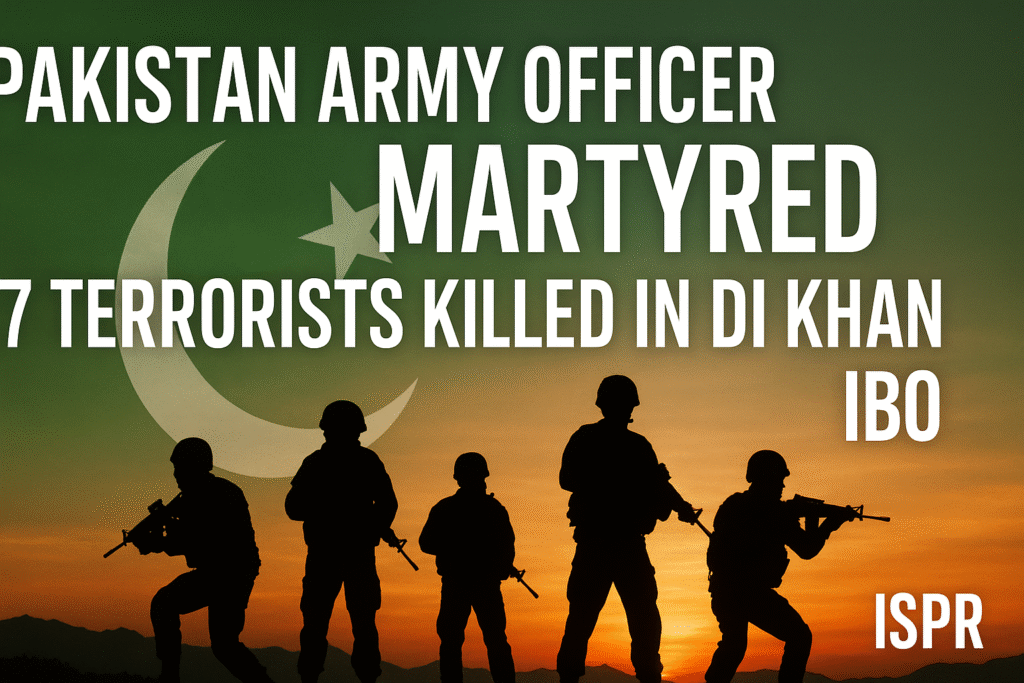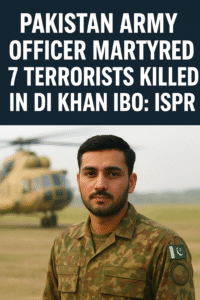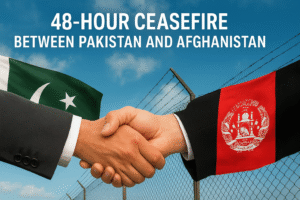Pakistan Army Officer Martyred in DI Khan IBO – 7 Terrorists Killed

Introduction
In a significant development highlighting Pakistan’s ongoing war against terrorism, a Pakistan Army officer, Major Sibtain Haider, embraced martyrdom while seven terrorists were eliminated in an Intelligence-Based Operation (IBO) in Dera Ismail Khan (DI Khan) district of Khyber Pakhtunkhwa (KP).
The operation was part of the military’s continued campaign to eradicate terrorist networks threatening national peace and stability. Pakistan Army officer martyred, 7 terrorists killed, DI Khan IBO, Major Sibtain Haider, ISPR. Pakistan Army officer martyred, 7 terrorists killed, DI Khan IBO, Major Sibtain Haider, ISPR.
According to the Inter-Services Public Relations (ISPR), the operation was carried out in the Daraban area of DI Khan, where the terrorists were hiding. During the intense exchange of fire, Major Haider, leading his troops from the front, was martyred. Security forces successfully neutralized seven militants belonging to Fitna al-Khwarij, a group involved in numerous terrorist attacks across Pakistan.
The news of this operation reverberated across the nation, drawing tributes from government leaders, military officials, and citizens, who hailed the martyred officer’s bravery and renewed their resolve against extremism.

The Operation in Daraban: A Detailed Account
The intelligence-based operation in Daraban was launched following actionable intelligence about the presence of terrorists planning attacks on security forces and law enforcement agencies.
When the security forces approached the identified hideout, terrorists opened fire, leading to a fierce gunbattle. In the ensuing encounter, Major Sibtain Haider, aged 30 and hailing from Quetta, was martyred while displaying extraordinary courage and leadership.
The soldiers under his command fought valiantly and managed to kill seven heavily armed militants. The ISPR reported that a significant cache of weapons, ammunition, and explosives was recovered from the site.
The military immediately cordoned off the area and launched a sanitization operation to ensure no remaining threats persisted. This standard follow-up ensures militants cannot regroup or re-establish control in the region.
The ISPR’s statement reaffirmed that Pakistan’s security forces are fully committed to eliminating terrorism and that sacrifices like Major Haider’s further strengthen the nation’s collective resolve.
Profile: Major Sibtain Haider – A Hero Remembered
Major Sibtain Haider, a 30-year-old officer from Quetta, epitomized courage and duty. Known among his peers as a dedicated and professional soldier, he consistently volunteered for frontline assignments.
Colleagues recall his commitment to his troops and his unshakable resolve in the face of danger. His leadership during the DI Khan operation exemplified the Army’s ethos of “leading from the front.”
The nation mourned his martyrdom, but his sacrifice became a symbol of hope and resilience. Across Pakistan, social media and news outlets echoed messages of pride and gratitude, honoring the bravery of Major Haider and countless other officers who have given their lives to safeguard the nation.
Who Were the Terrorists? Understanding Fitna al-Khwarij
The militants killed in the DI Khan operation were identified as part of Fitna al-Khwarij, a term the Pakistani security establishment uses to describe groups like the Tehrik-e-Taliban Pakistan (TTP) and affiliated outfits operating in KP and Balochistan.
“Khwarij” is a religious reference denoting extremists who deviate from mainstream Islamic teachings. By using this term, the military aims to expose the ideological distortions of these militants and deny them any moral legitimacy.
These terrorist groups are believed to have carried out numerous attacks targeting military convoys, police stations, and civilians. Over the past year, they have intensified operations in southern KP, leveraging mountainous terrain and border vulnerabilities.
According to official sources, the group’s operatives have been involved in ambushes, extortion, and sabotage of infrastructure projects. The Daraban encounter, therefore, was not an isolated incident but part of a broader campaign to dismantle their networks.
Dera Ismail Khan: A Strategic Flashpoint
The DI Khan district holds immense strategic importance. Located near the tribal belt and bordering South Waziristan, it serves as a gateway for militants attempting to infiltrate from Afghanistan.
Historically, this region has seen multiple security operations targeting TTP hideouts. Its rough terrain, sparse population, and complex tribal dynamics make counterterrorism particularly challenging.
Security experts note that the recent uptick in violence in southern KP reflects attempts by terror groups to re-establish strongholds lost after major military operations such as Zarb-e-Azb and Radd-ul-Fasaad.
The DI Khan IBO demonstrates that despite these challenges, Pakistan’s security forces continue to dominate the operational field through timely intelligence, coordination, and swift execution.
Connection to Orakzai IBO and Other Recent Operations
The DI Khan operation came on the heels of another major IBO in Orakzai district, where 11 security personnel, including senior officers, embraced martyrdom while 19 terrorists were neutralized.
The two back-to-back operations illustrate Pakistan’s renewed offensive posture against militant organizations. The Corps Commanders’ Conference held earlier in October emphasized the necessity of eliminating terrorism “from its roots” and preventing any re-emergence of organized militant cells.
Analysts believe these operations are strategically linked, aiming to deny militants any safe haven in KP or adjacent tribal regions. The synchronized timing also signals enhanced intelligence coordination across military commands.
ISPR’s Message: National Resolve Against Terrorism
The ISPR’s statement following the DI Khan operation carried strong undertones of national unity and resilience. It stated that the Pakistan Army remains steadfast in its mission to eliminate terrorism and defend the country’s sovereignty.
It further declared that “sacrifices of our brave sons only strengthen our resolve to ensure peace and stability.”
This consistent messaging reinforces public morale while deterring extremist narratives. By labeling terrorist networks as “fitna,” the ISPR underscores that such violence contradicts both Pakistan’s national interest and Islamic principles.
Political and Public Reactions
Political leaders, military officials, and citizens across Pakistan paid heartfelt tributes to Major Haider and the soldiers involved in the DI Khan operation.
President Asif Ali Zardari praised the Army for its successful counterterror mission and expressed profound grief over the martyrdom of Major Haider. He stated that the officer’s bravery would forever be remembered as a symbol of the nation’s unwavering strength.
Interior Minister Mohsin Naqvi echoed similar sentiments, emphasizing that the fight against terrorism must continue “until the last hideout of extremists is destroyed.”
Khyber Pakhtunkhwa Governor Faisal Karim Kundi lauded the troops for their courage, while local political representatives called for increased support for security personnel operating in the southern districts.
Across social media, hashtags like #MajorSibtainHaider and #PakArmyZindabad trended for hours, as citizens shared messages of respect and unity.
Security Situation in Pakistan: The Bigger Picture
Pakistan’s fight against terrorism has entered a new phase. Although major military operations from 2014 to 2017 significantly reduced militant strongholds, sporadic attacks have resurfaced in recent years.
In 2025 alone, counterterror operations have intensified across KP and Balochistan due to increased militant activity near the Afghan border. Analysts point to a combination of factors — including regional instability, porous frontiers, and external influence — as key drivers of this resurgence.
According to national security assessments, KP remains the most affected province, accounting for more than two-thirds of recent terrorism incidents. DI Khan, Tank, North Waziristan, and Bajaur districts have seen consistent engagement between security forces and insurgents.
Challenges Ahead: Counterterrorism Realities
Despite numerous operational successes, counterterrorism in Pakistan faces persistent challenges:
-
Geographical Complexity: Mountainous terrain and cross-border sanctuaries make tracking militants difficult.
-
Local Support Networks: Terrorists often exploit tribal loyalties or coercion to gain logistical support.
-
External Factors: Alleged foreign sponsorship and the instability in Afghanistan contribute to recurring threats.
-
Economic Strain: Sustained military operations require significant resources, which can pressure national budgets.
-
Information Warfare: Militants attempt to manipulate narratives online, necessitating parallel information management efforts.
Addressing these challenges requires a holistic approach that includes governance reforms, development in conflict zones, and coordination between civilian and military institutions.
Pakistan’s Comprehensive Strategy Against Terrorism
The DI Khan IBO is part of Pakistan’s broader national security framework that combines military, intelligence, diplomatic, and developmental measures.
Key components of this strategy include:
-
Kinetic Operations: Targeted raids and IBOs to dismantle militant infrastructure.
-
Intelligence Fusion: Improved coordination between civilian and military intelligence agencies.
-
Border Management: Enhanced surveillance and fencing along the Pak-Afghan frontier.
-
De-Radicalization Programs: Initiatives to rehabilitate individuals influenced by extremist ideologies.
-
International Cooperation: Diplomatic engagement with allies and regional partners to curb external financing of terrorism.
Through these measures, Pakistan aims not only to neutralize immediate threats but also to address the root causes of extremism.
Human Cost and National Resolve
Every successful operation comes at a cost — the lives of brave soldiers who lay down everything for their homeland. The martyrdom of Major Sibtain Haider is a stark reminder of this sacrifice.
His courage has inspired renewed patriotism, with many citizens calling for greater recognition of security personnel serving in volatile regions.
Families of martyrs often express mixed emotions — immense pride tempered by grief. The government continues to provide support through financial aid, employment opportunities, and educational benefits for dependents of the fallen heroes.
In the words of a senior officer: “Our martyrs are not just soldiers; they are the reason the flag flies high.”
Future Outlook: Toward a Peaceful Pakistan
The successful DI Khan operation underscores Pakistan’s determination to maintain peace and stability. However, the path ahead remains challenging.
For lasting peace, Pakistan must continue investing in:
-
Intelligence technology for predictive threat assessment.
-
Socio-economic uplift in conflict-prone areas.
-
Youth engagement programs to counter radical narratives.
-
Regional diplomacy to prevent cross-border facilitation of terrorism.
Military operations can suppress terrorism, but only a unified national effort — involving the government, security institutions, and civil society — can ensure permanent peace.
The Operation in D.I. Khan
According to ISPR, the operation was launched after intelligence reports indicated the presence of a terrorist hideout in the Darazinda area of D.I. Khan District. Security forces cordoned off the location, triggering an intense exchange of fire.
During the firefight, Captain Muhammad Faraz, aged 27, embraced shahadat (martyrdom) while displaying exemplary courage and leadership. His sacrifice symbolizes the army’s ongoing commitment to national defense and peace.
The ISPR confirmed that seven terrorists were killed in the operation. Weapons, ammunition, and communication equipment were recovered from their possession. The slain militants were reportedly involved in several terrorist activities targeting both security forces and civilians in the region.
Official Statement by ISPR
The ISPR’s official statement read:
“During the operation, an intense fire exchange took place between the troops and the terrorists. Resultantly, seven terrorists were neutralized, while Captain Muhammad Faraz embraced shahadat. The operation reaffirms the resolve of Pakistan’s armed forces to eliminate terrorism from every corner of the country.”
The ISPR further added that “sanitization operations” are ongoing in the area to track down any remaining elements linked to the terrorist network.
Who Was Captain Muhammad Faraz?
Captain Muhammad Faraz, a young and valiant officer, hailed from Okara District, Punjab. Known among his peers for his courage and dedication, he served in several high-risk operational areas during his career. His martyrdom has been widely mourned across military ranks and among civilians.
Social media platforms were filled with tributes from citizens, journalists, and political leaders honoring his bravery. Hashtags like #ShaheedFaraz and #PakistanArmyZindabad trended on X (formerly Twitter), reflecting the nation’s collective respect for its fallen heroes.
D.I. Khan: A Critical Region in Counterterrorism
D.I. Khan, situated in southern Khyber Pakhtunkhwa, has long been a hotspot for militant activity due to its proximity to South Waziristan and the Afghan border. The area has witnessed a resurgence in terrorist attacks since the Taliban’s takeover of Kabul in 2021.
Analysts suggest that groups such as Tehreek-e-Taliban Pakistan (TTP) and splinter factions continue to exploit porous borders and tribal networks to launch attacks inside Pakistan. Operations like the recent D.I. Khan IBO are part of a larger counterterrorism strategy designed to prevent these militants from re-establishing strongholds.
Recent Surge in Terrorist Activity
In recent months, Pakistan has faced an uptick in terrorism across Khyber Pakhtunkhwa and Balochistan. Multiple attacks have targeted police, Frontier Corps, and military installations.
According to security sources, many of these attacks are planned and executed from across the border, with the TTP seeking to regroup under its new leadership. The Pakistani government has intensified border security, deployed surveillance drones, and carried out joint operations to dismantle sleeper cells.
The D.I. Khan operation is seen as a continuation of Operation Radd-ul-Fasaad, launched in 2017 to eliminate residual terrorist threats and strengthen domestic security.

National Response
The news of Captain Faraz’s martyrdom drew condolences from national leaders and institutions.
Prime Minister Shehbaz Sharif praised the officer’s bravery, stating:
“The nation salutes the sacrifices of our brave sons who lay down their lives for the defense of Pakistan. Captain Faraz’s martyrdom will never be forgotten.”
Army Chief General Asim Munir also paid tribute, reaffirming that sacrifices by security forces will not go in vain.
“The blood of our martyrs strengthens our resolve. We will ensure that every drop of blood is avenged, and peace is fully restored,” the COAS said.
Political parties, including the Pakistan Peoples Party (PPP) and Pakistan Tehreek-e-Insaf (PTI), also expressed solidarity with the armed forces.
ISPR’s Counterterrorism Vision
The ISPR has repeatedly emphasized that the armed forces are determined to ensure lasting peace through relentless operations. The recent IBO reflects an advanced intelligence coordination mechanism among military, paramilitary, and intelligence agencies.
Since the start of 2025, hundreds of IBOs have been conducted nationwide, leading to the elimination of high-value targets and the recovery of large caches of weapons.
These operations align with Pakistan’s National Action Plan (NAP), aimed at combating terrorism, extremism, and militancy through comprehensive security, judicial, and social reforms.
The Human Cost of Peace
While the elimination of seven terrorists is a significant tactical success, the loss of another brave officer underscores the high price Pakistan continues to pay in its fight against terror.
Over the past two decades, more than 70,000 Pakistanis, including soldiers, police, and civilians, have lost their lives due to terrorism. Yet, the nation’s resilience remains unbroken.
The martyrdom of Captain Faraz joins a long list of sacrifices that define the nation’s journey toward stability and security.
Public Sentiment and Media Coverage
News channels across Pakistan highlighted the operation, with commentators praising the professionalism and valor of the troops involved. Social media platforms echoed calls for unity and continued support for Pakistan’s armed forces.
Citizens across the country held Fateha prayers and candlelight vigils in memory of the fallen officer. The sentiment on digital platforms reflects a collective understanding that peace demands sacrifice and vigilance.
Conclusion
The martyrdom of Major Sibtain Haider and the elimination of seven terrorists in DI Khan stand as a powerful testament to Pakistan’s ongoing fight against extremism.
This operation highlights not only the bravery of the armed forces but also the enduring resilience of a nation that refuses to bow before terror.




